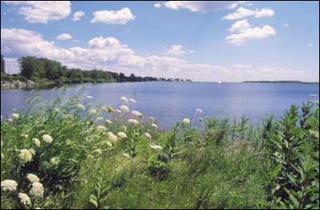
July 2nd, 2005 - Parks Canada recently confirmed that it is considering building a major exhibition "discovery centre" to showcase the nation's national parks and historic sites at the base of the Leslie Street Split, also known as Tommy Thompson Park. While on paper this sounds like a great tourism boost, park advocates (and I will include myself in that group) aruge that the proposed development will destroy the natural wildlife corridor that has developed over the past 50 years. Yet another case of "development vs. nature" on Toronto's waterfront.
Background
The Leslie Street Split was created from material excavated to build Toronto's new office towers in the 1950s. The Split was originally planned to be the outer harbour for Toronto, but the increased in shipping never happened. Since then, the Split has been largely untouched and eventually became known as Tommy Thompson Park (after a hard-fought fight between the city and a citizen group called "Friends of the Split").
An Accidental Wildnerness
Meadows, forests, wetlands and mud flats have since been developed on the Split land. The Split is home to hundreds of different species of birds, butterflies, and mammals. It is also a designated Important Bird Area by Birdlife International. Rabbits, groundhogs, raccoons, and insects of all kinds also make the Split their home, despite being separated from the rest of the City's natural heritage system (due to the contaminated brownfield lands that make up much of the Portlands).
The entire Split could be said to be an accidental wilderness - while the land was man-made (as in done by landfilling), the wildlife that developed on the land was purely accidental. As a result, Tommy Thompson Park has more an "organic or wildnerness look", as compared to a typical neigbhourhood park.
Parks Canada Discovery Centre
The Discovery Centre will no doubt disrupt the "accidental wildlife" that has moved into the Split. The proposed building will include a large parking facility, access roads, water and other services that will pave over meadows, forest, and wetlands. The goal of the Discovery Centre is not only to showcase Canada's natural heritage, but according to Parks Canada, also provide "educational opportunities for visitors to learn about migrating birds and wetland habitat restoration work."
The Pros and Cons
Pros
- the project will bring about change to one of the most neglected areas of Toronto. The Portlands-Waterfront Area needs much development and the Discovery Centre could act as one of the projects that could bring about change. With our failed Olympic bid(s), the incentive for the federal and provincial government to pour money into the area has almost completely disappeared. The project will be part of the new Waterfront Park being planned by the Toronto Waterfront Revitalization Corp.
- the Discovery Centre will bring in $ to the Toronto economy.
- the Centre will serve an educational purpose - what a great place to learn about ecological succession eh ?
Cons
- parks are not just manicured lawn; TT Park represents one type of park (a natural or "organic" park) and it deserves the same recognition as the more famous man-made parks (i.e. High Park, Sunnybrook, etc).
- "we need to be in fairly close proximity to wildlife to learn about them" - sure you do, but by placing a big building, with a sea of parking, and a network of roads that would connect the Centre to the City, you will no doubt be paving over and intruding the very same wildlife that you have came to the Split to study. It is like the woman who complained about seeing deer when she decided to buy a house near a forest so she could be close to nature (that's another story).
- Nature vs. development - why can't we just keep what little urban wilderness we have left in peace ? The new Centre will cut off the Split, disrupt wildlife corridors, and generate pollution (water/trash/noise/light). By developing the Split, Parks Canada (who should know better than anyone !) will actually be destroying the very same unique natural habitat that attracted the Centre at the first place.
Can the Split be saved ?
There is no doubt that pressure for development on the Split will continue to rise. What's important for councillors is to remember that NOT every park looks like a playground. Natural ecological parks, such as the Split, are just as important to the aesthetics and natural functions of the city. Look at High Park - the City has been trying to restore the ecological functions of the park, after years of paving and building. While the Discovery Centre is a great idea, it does not necessairly have to be on the Split - why not build it on the Portlands (on a brownfield site perhaps - a great way to learn about remediation) ? The Split definitely deserves saving - but will the City and Parks Canada listen ?

No comments:
Post a Comment